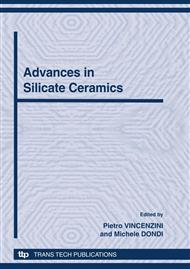p.102
p.108
p.114
p.120
p.126
p.135
p.145
p.153
p.159
Testing of Photocatalytic Activity of Self-Cleaning Surfaces
Abstract:
Due to relatively successful application of TiO2 photocatalysis in the field of self-cleaning surfaces, a reliable and appropriate quantitative method for determining the self-cleaning efficiency of the products (photocatalyst films on different supports) should be widely recognized and established. Currently, the two standard methods are based on photobleaching of methylene blue aqueous solution in contact with thin solid catalyst layer, and on photodegradation of a solid fatty deposit (e.g. stearic acid) over catalyst layer followed indirectly by water contact angle (CA) measurements. Another method proposed recently is based on the entrapment of an organic dye in a solid polymer matrix deposited over the photocatalyst layer. Upon illumination, the dye (e.g. resazurin) is reduced by the photogenerated electrons to the form of a different colour or to the bleached form. Recently, a new method for determination of self-cleaning activity of photocatalytic surfaces was developed in our laboratory. It is based on the deposition of a transparent solid layer comprising terephthalic acid over the photocatalytic surface. When such a system is irradiated, among the other degradation products also a hydroxyterephthalic acid is formed due to a reaction between photoexcited TiO2 and terephthalic acid. Hydroxyterephthalic acid is a highly fluorescent molecule and can be easily detected by HPLC-FLD or spectrofluorimeter. Many different samples were tested using this method and using the standard method based on photodegradation of a solid fatty deposit over the catalyst layer. Regarding the sample (substrate) type, the focus was given to the self-cleaning ceramic tiles coated with TiO2-SiO2 thin films that were produced in cooperation with the major manufacturer of floor ceramic tiles in Slovenia, Martex d.o.o.. In case of self-cleaning ceramics and some other sample types, the advantages of the new method over standard methods were highlighted and critically evaluated.
Info:
Periodical:
Pages:
126-134
Citation:
Online since:
October 2010
Authors:
Price:
Сopyright:
© 2010 Trans Tech Publications Ltd. All Rights Reserved
Share:
Citation:


